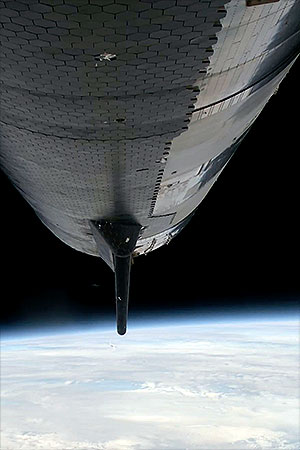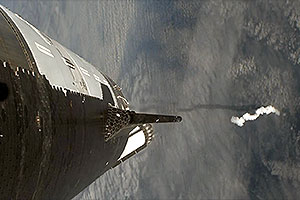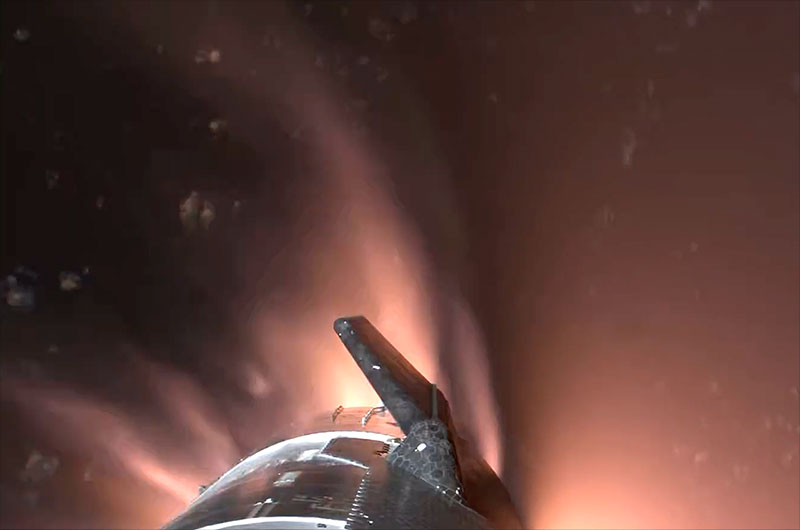 advertisements advertisements
|

|
SpaceX Starship coasts then crashes on mostly-successful third test
March 14, 2024 — SpaceX's Starship flew faster and further than it has ever gone before, but just missed achieving a fully successful third test flight when it was lost during its reentry into Earth's atmosphere.
The world's largest spacecraft and most powerful rocket to reach space, Starship and its Super Heavy booster flew a perfect ascent on Thursday (March 14). Lifting off from SpaceX's Starbase in Cameron County, Texas at 8:25 a.m. CDT (1325 GMT), the towering vehicle soared well beyond what it reached on the second of its test flights four months ago.
"We got to say a huge congratulations to our teammates and everyone who has supported the Starship program," said Siva Bharadvaj, a space operations engineer at SpaceX who co-hosted the company's live webcast of the launch. "There's been flames and RUDs ["rapid unscheduled disassemblies," SpaceX's term for explosions] along the way, but the third time is the charm. We made it to space!"
For the first four minutes, Starship and Super Heavy flew as planned, from ignition of the booster's 33 engines through MECO (most engines cut off) to a clean hot-fire separation, where the upper stage spacecraft fired its Raptor engines before the Super Heavy first stage dropped away.
It was at that same point during the previous flight did things start to go awry, After flipping its orientation to fire its engines and reverse course, several of the Super Heavy's engines shut down and one exploded, destroying the booster. Starship, in the meantime, had continued to ascend towards space, but a leak-induced explosion cut off its flight computers and shot down its engines, triggering its flight safety system to terminate the vehicle.
On Monday, Super Heavy conducted a successful "boostback" burn and was beginning a landing burn to set up for a soft splashdown in the Gulf of Mexico. The plan was for the booster to reignite 13 of its engines to slow its approach and then keep three engines burning until it made contact with the water.
"We did make it all the way to the landing burn this time, but didn't light all of the engines that we expected and we did lose the booster. We will have to go through the data to figure out what happened," said Dan Huot, SpaceX's communications manager.
While Super Heavy was descending, Starship soared into space, reaching 145 miles (234 km) above Earth. During the coast phase preceding its reentry, the vehicle attempted to transfer propellant — in this case, liquid oxygen — between two of its tanks. The test, still pending confirmation, may advance SpaceX's plans to refuel Starship in Earth orbit before proceeding on to the moon and Mars.
Starship also demonstrated opening and closing its "Pez" bay door. Named after the candy dispenser, the slot will be used to deploy SpaceX's Starlink broadband internet satellites and other small payloads.
It was through the use its Starlink network and NASA's Tracking and Data Relay System (TDRS) satellites that SpaceX was able to broadcast live video from aboard Starship as it flew through space and as it began its reentry into Earth's atmosphere, the latter showing the the bright glow of plasma as it built up around the vehicle.
"Starship is so big that we're hoping that the plasma field doesn't entirely blanket the vehicle. Right now, it is not, the Starlinks are still communicating and still capturing the data and video we see here," said Kate Tice, a quality engineering manager at SpaceX and webcast co-host. "We've never seen anything like this before. This is the biggest flying object ever in space."
The plasma field did eventually overcome the vehicle, though, and live views cut off before connections to both Starlink and TDRS dropped out at the same time, an indication that the vehicle had come apart about 49 minutes into the planned hour-long flight. Had Starship survived reentry, the next step was for it to drop into the Indian Ocean.
"We haven't heard from the ship up until this point and the team has made the call Starship has been lost. So no splashdown today," said Huot.
Starship's early demise was a disappointment, but recovery of the vehicle was not a part of this test flight's plan. Even if everything had gone right, both Starship and Super Heavy would have been left to sink to the seafloor.
One objective that SpaceX had hoped to achieve, though, was to relight one of Starship's six Raptor engines while in space to demonstrate that the spacecraft could perform a deorbit burn and return safely to Earth. The company called off the test due to "vehicle roll rates" during the coast.
In addition to SpaceX using Starship to launch more of its Starlink satellites and its own planned commercial crewed missions around the moon and to Mars, the company is also developing a version of the spacecraft to serve as NASA's lunar lander on the first mission to return astronauts to the moon's surface in more than 50 years. The agency awarded SpaceX a $2.9 billion contract to support the Artemis III mission, now targeted to launch in late 2026, with the first woman and next American to walk on the moon.
Monday's test flight coincided with SpaceX's 22nd year in operation. Since March 14, 2002, SpaceX has launched 319 rockets, recovered 283 stages, deployed almost 6,000 Starlink satellites and delivered 49 people to and from Earth orbit.
"Congratulations SpaceX team!" Elon Musk, SpaceX founder and CEO, wrote on X. "Starship will make life multiplanetary, Starship will take humanity to Mars." |
|

SpaceX's Starship spacecraft is seen during the coast phase of its third test flight on Thursday, March 14, 2024. (SpaceX via X)

SpaceX's Starship lifts off on its third flight test atop the thrust of 33 Raptor engines powering its Super Heavy booster. (SpaceX)

With its plume seen below, SpaceX's Super Heavy booster drops away from Starship after their hot-fire separation. (SpaceX via X)

SpaceX's mission patch for Starship's third test flight. (SpaceX) |

A plasma field builds up around SpaceX's Starship as it reenters Earth's atmosphere on its third test flight, Thursday, March 14, 2024. (SpaceX via X) |
|

© collectSPACE. All rights reserved.
|
|

|

|
